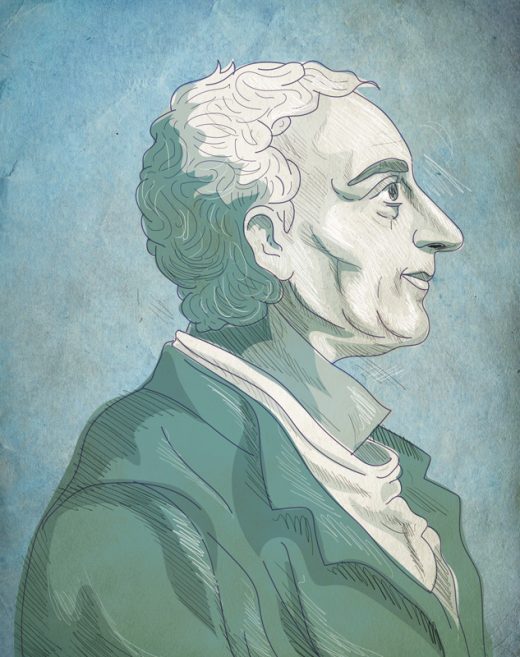In 1901, when Baron Charles Alexander de Cosson and his family arrived in Florence, he had planned to stay for only two months. Instead, he would remain there for the rest of his life, until his death 28 years later. For this inveterate traveller, it was most likely not his first visit to the city, but by the time he arrived at the dawn of the new century and took up lodgings in via Ghibellina, he had already firmly established his reputation as a gentleman scholar, expert antique arms and armour collector and dealer with a long list of distinguished clients. Among these was the French aristocrat Charles Maurice de Talleyrand-Périgord, Duc de Dino (1843-1917), who in 1896 employed de Cosson as his arms and armour consultant to refine and improve his already fine collection of almost 500 richly embellished, mainly European pieces from the 15th to the 17th century.

Illustration by Leo Cardini
In 1901, the duke paid de Cosson to write the collection’s catalogue and to advise him on its sale, which took place in 1904 when, sight unseen, it was sold to the Metropolitan Museum of Art in New York for the then staggering sum of $250,000, the highest the museum had ever paid for an exhibit. Other clients and friends included the American collector Rutherfurd Stuyvesant (1843-1909), who played an important role in securing the de Dino collection for the Metropolitan, and the wealthy Anglo-Florentine collector Frederick Stibbert (1838–1906). From correspondence, it appears that de Cosson probably met Stibbert in London in 1889, but the baron did not see the collection of weapons and armour that Stibbert was procuring for the magnificent museum-home he was painstakingly creating until after his 1901 arrival in town.
Charles Alexander de Cosson was born on August 28, 1846 into an aristocratic family that had fled to England in the wake of the French Revolution. A boyhood love of arms and armoury encouraged and nurtured by his parents, combined with extensive travels throughout Europe and Africa, particularly in Egypt and Ethiopia, would lead to a lifelong passion and later provide de Cosson with the practical means for supporting his own family after his marriage in 1876 to Cecilia Nefeeseh Bonomi, the daughter of the artist and renowned Egyptologist Joseph Bonomi the Younger (1796-1878).
In 1878, by then familiar with the major European collections and dealers, de Cosson was invited by the Court of the Company of Cutlers in London to exhibit 80 swords in an exhibition that attracted 15,000 visitors in a little over a fortnight. Two years later, another show established de Cosson’s reputation as an authority on the subject, laying the foundations for a future scholarly approach to the study of arms. This was based on the research he did in preparation of the catalogue entitled Ancient Helmets and Examples of Mail for an exhibition held by the Royal Archaeological Institute in London, which he wrote together with his friends William Burges (1827-81), England’s most famous Gothic Revival architect, and W.G.B. Lewis, another eminent architect, who did the drawing. The volume has stood the test of time, still in print today.
Among his friends and colleagues, de Cosson counted Sir Guy Francis Laking (1875-1919), who became the keeper of the king’s armoury at Windsor, a post King Edward VII created specifically for him, inspector of the armoury at the Wallace Collection and the first keeper of the Museum of London. Laking was strongly influenced by de Cosson, who penned the introduction to Laking’s five volume opus, Record of European Armour and Arms Through Seven Centuries. Another valued colleague was James G. Mann (1897–1962), who later would become the keeper of the Wallace and master of the armouries in the Tower of London.
For fellow arms enthusiasts, de Cosson founded the Kernoozers Club in 1881 and served as its first president. He was also a member of the Society of Antiquaries of London and wrote for prestigious publications like the Archaeological Journal.
Following the death of Frederick Stibbert on April 10, 1906, details of his will were revealed in which he left his museum containing 50,000 pieces and its beautiful garden to the English government with the proviso that the collection was to be kept together in the place where it was and without modification. Should the government refuse the bequest, the property was to pass to the City of Florence. Stibbert was encouraged to make this patriotic bequest by Laking and, initially, it appeared that the English government would accept it. At this point, de Cosson sent a letter to the Foreign Office offering his services as the first keeper or director of the Stibbert Museum, outlining his qualifications and experience, his linguistic prowess and his desire to produce a catalogue of the contents of the armoury and to edit Stibbert’s manuscripts and papers.
A change in the English government, however, brought a turnabout whereby it renounced its entitlement to Stibbert’s legacy. This was good news for the City of Florence, which eagerly accepted it, but not for de Cosson who, despite his undeniable eligibility, failed to get the job.
The Stibbert Museum is situated in via Federigo Stibbert 26, Florence, and is open on Monday to Wednesday from 10am to 2pm, and Friday to Sunday from 10am to 6pm. It is closed on Thursday. For further information, see www.museostibbert.it/en.







